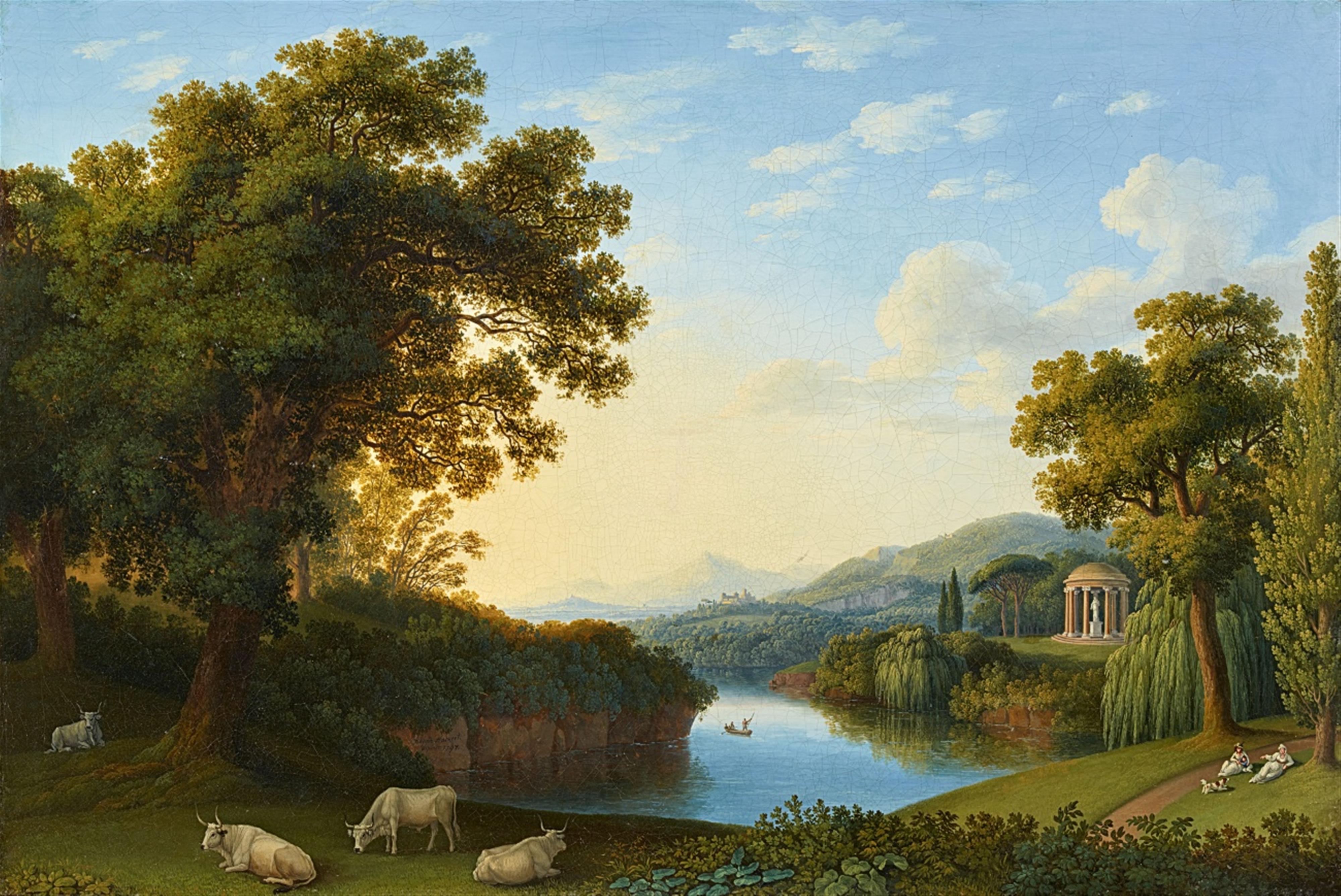Jacob Philipp Hackert
Landscape with Motifs from the English Garden in Caserta
Oil on canvas (relined). 66.5 x 97.5 cm.
Signed and dated lower left: Filippo Hackert dipinse 1797.
Following his artistic training in Berlin (1753-1762) and a longer stay in Paris (1765-1768), the landscape painter Jakob Philipp Hackert settled in Rome in the winter of 1768. There, he established a successful career painting works for elegant international visitors to Rome, as well as for the city's aristocrats and clerics. In 1786, he was called to the Neapolitan court by the Bourbon King Ferdinand IV, where he stayed in luxurious circumstances for several years. The painter planned on remaining in this privileged position for the rest of his life, but he was forced to flee the city during the French occupation of 1799, leaving behind almost everything he owned. Hackert settled in Florence, where he began to rebuild his life and career with characteristic tenacity. He continued to work for international patrons and was soon able to purchase a small manor house in Careggi near Florence, where he began to take an interest in agriculture alongside painting. He died in Florence, unmarried and without offspring, on 28th April 1807 and is buried at the Protestant cemetery in Livorno.
King Ferdinand VI began laying out spacious new grounds at the palace gardens of Caserta in 1786, the same year that he called Hackert to Naples. The new gardens were carried out in the English style. Hackert followed their construction with great interest, not least because they helped inspire the development of his own landscape compositions. The main initiator of the English gardens at Caserta was Hackert's friend, the British envoy Sir William Hamilton (1730-1803). In April 1786 he instigated the employment of the gardener John Andrew Gräfer (1746-1802), whom Hackert soon also befriended.
The artist made three drawings of the gardens in 1788, showing parts that were already completed, there are also later drawings dated 1793 and 1794. At the king's behest, Hackert painted a large work in gouache in 1792 showing a panoramic view of the gardens looking towards Mount Vesuvius in the south and showing the town of Maddaloni on Monte San Michele on the left. He painted a further variation of the park landscape in 1795, this time depicting a small pond with a weeping willow in the mid-ground flanked by pine trees, oaks, and cypress trees planted casually side by side.
Hackert finally painted four more works in this “new genre” in 1797, of which the present canvas is one. The viewer looks out across a river flowing from the mid-ground to the fore. Trees line its banks, and once again we recognise several weeping willows. A round temple with a statue on a plinth is shown nestled among the pine and cypress trees on the river's right bank. The scene is highly reminiscent of the English gardens at Caserta, where Hackert's friend, the architect Carlo Vanvitelli (1740-1821), constructed a small round temple in the centre of a labyrinth at the king's request in 1792 (not a typical element of a landscape garden, but it was the king's wish). The temple can also be seen in Hackert's 1792 gouache, but the statue - presumably depicting Flora or Venus - is an addition by the artist.
In the right foreground of the work, two elegantly dressed ladies recline together with a small girl and a dog on a well-kept lawn. They represent the park element of the gardens, whereas the cows in the left foreground evoke a rural atmosphere. The way in which the two aspects meld seamlessly into each other recalls Goethe's remark that the area around Caserta was one immense garden.
In the distance we see a settlement with a fortified tower on a hill. The motif is reminiscent of the small town of Maddaloni on the Tifatina hills at the foot of Monte San Michele which borders the plain of Caserta in the south. The town can also be seen in the left background of the gouache depiction of the English gardens from 1792.
We would like to thank Dr Claudia Nordhoff for her kind support in cataloguing this piece. The present catalogue entry is a heavily abridged version of her detailed expertise for this painting.
Certificate
Dr Claudia Nordhoff, Rom 15.3.2020.
Provenance
Prince Adalbert of Prussia (1884 - 1948), Bad Homburg. - Christie´s New York 31.05.1989, lot 87. - Collection of Nancy Richardson. - Christie´s New York 27.05.2017. - Scandinavian private collection.
Literature
C. Norhoff/H. Reimer, Jacob Philipp Hackert /1737 - 1907). Verzeichnis seiner Werke, 1984, II, no. 265.

